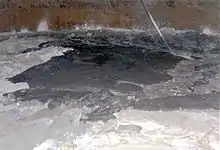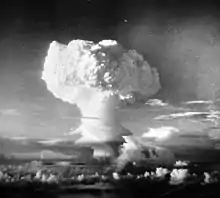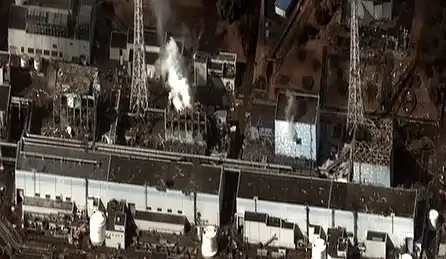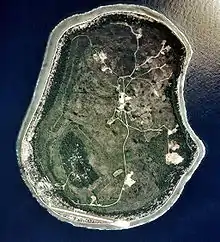Environmental disaster
An environmental disaster or ecological disaster is a catastrophic event regarding the environment due to human activity.[1] This distinguishes it from the concept of a natural disaster. It is also distinct from intentional acts of war such as nuclear bombings.


In this case, the impact of humans' alteration of the ecosystem has led to widespread and/or long-lasting consequences.[2] It can include the deaths of animals (including humans) and plants, or severe disruption of human life, possibly requiring migration.[3]
Environmental disasters
Environmental disasters can have an effect on agriculture, biodiversity, the economy and human health. The causes include pollution, depletion of natural resources, industrial activity or agriculture.[4]

- Seveso disaster, 1976 – Release of dioxin.
- Love Canal, 1978 - Neighborhood in Niagara Falls, New York that was contaminated by 21,000 tons of toxic chemicals, including at least twelve that are known carcinogens (halogenated organics, chlorobenzenes, and dioxin among them), from a former chemical waste dump site. President Carter declared a state of emergency in 1978, and it eventually led to the destruction of homes and relocation of more than 800 families. The effects of the disaster led to the 1980 Comprehensive Environmental Response, Compensation, and Liability Act, better known as Superfund. The Love Canal disaster is also credited as the start of the environmental activism movement in the United States.
- Amoco Cadiz oil spill, 1978 – the vessel broke in two, releasing its entire cargo of 1.6 million barrels (250,000 m3) of oil.
- Ok Tedi environmental disaster, 1984. As of 2006, mine operators have discharged about two billion tons of tailings, overburden and mine-induced erosion into the Ok Tedi river system. About 1,588 square kilometres (613 sq mi) of forest has died or is under stress.
- Bhopal disaster, 1984 – Release of methyl isocyanate gas and other chemicals Some estimate 8,000 people died within two weeks. A government affidavit in 2006 stated the leak caused 558,125 injuries including 38,478 temporary partial and approximately 3,900 severely and permanently disabling injuries.
- Chernobyl disaster, 1986 – The official Soviet count of 31 deaths has been disputed. An UNSCEAR report places the total confirmed deaths from radiation at 64 as of 2008. The eventual death toll could reach 4,000. Some 50 emergency workers died of acute radiation syndrome, nine children died of thyroid cancer and an estimated total of 3940 died from radiation-induced cancer and leukemia.
- Hanford Nuclear, 1986 – The U.S. government declassifies 19,000 pages of documents indicating that between 1946 and 1986, the Hanford Site near Richland, Washington released thousands of US gallons of radioactive liquids. Radioactive waste was both released into the air and flowed into the Columbia River (which flows to the ocean).
- Exxon Valdez oil spill, 1989 – spilled 260–750 thousand barrels (41,000–119,000 m3) of crude oil.
- Prestige oil spill, 2002 – spilled over 20 million US gallons (76,000 m3) of two different grades of heavy fuel oil.
- Prudhoe Bay oil spill, 2006 – spilled up to 267,000 US gallons (1,010 m3; 6,400 bbl).
- Kingston Fossil Plant coal fly ash slurry spill, 2008 – spilled 1.1 billion US gallons (4,200,000 m3) of slurry from a coal plant, covering 300 acres, flowing down several rivers, destroying homes and contaminating water. Volume spilled was over 7 times as much as the volume of oil spilled in the Deepwater Horizon disaster.
- Deepwater Horizon oil spill, 2010 – An explosion killed 11 men working on the platform and injured 34 others. The gushing wellhead was capped, after it had released about 4.9 million barrels (780,000 m3) of crude oil.
- Fukushima Daiichi nuclear disaster, 2011 – was an energy accident, initiated primarily by the tsunami following the Tōhoku earthquake on 11 March 2011. Immediately after the earthquake, the active reactors automatically shut down their sustained fission reactions. The insufficient cooling led to three nuclear meltdowns, hydrogen-air explosions, and the release of radioactive material. Level 7 event classification of the International Nuclear Event Scale.
Climate change and disaster risks
A 2013 report examined the relationship between disasters and poverty. It concludes that, without concerted action, there could be up to 325 million extremely poor people living in the 49 countries most exposed to the full range of natural hazards and climate extremes in 2040.[7]
See also
References
- booty buttJared M. Diamond, Collapse: How Societies Choose to Fail or Succeed, 2005
- Illustrated overview of environmental disasters due to human activity Archived 2007-02-08 at the Wayback Machine, including deforestation, soil erosion and the biodiversity crisis.
- End-of-the-World Scenario:ecological Disaster
- Environmental Disaster Videos Archived 2007-12-03 at the Wayback Machine on Gaiagonewild.com
- Richard Schiffman (12 March 2013). "Two years on, America hasn't learned lessons of Fukushima nuclear disaster". The Guardian.
- Martin Fackler (June 1, 2011). "Report Finds Japan Underestimated Tsunami Danger". New York Times.
- Andrew Shepherd, Tom Mitchell, Kirsty Lewis, Amanda Lenhardt, Lindsey Jones, Lucy Scott, Robert Muir-Wood, 2013; The geography of poverty, disasters and climate extremes in 2030; accessed 29/10/2013 http://www.odi.org.uk/publications/7491-geography-poverty-disasters-climate-change-2030
- Republic of Nauru. 1999. Climate Change – Response. First National Communication – 1999. Under the United Nations Framework Convention on Climate Change, United Nations
Further reading
- Davis, Lee (1998). Environmental Disasters. New York: Facts on File, Inc. ISBN 0-8160-3265-3.
